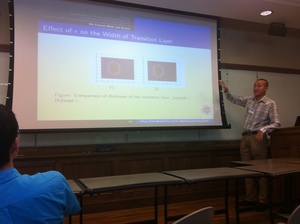Ph.D. student Rui Gu recently traveled to the University of Tennessee at Knoxville to present his research on vesicle-substrate adhesion at the Southeastern-Atlantic Regional Conference on Differential Equations held September 21 - 22, 2013. In his workshop session, Gu used movies to demonstrate his model, and presented the most recent results of his research on how to solve a vesicle-substrate adhesion problem using two phase field functions. The conference was designed especially to promote education and research in the differential equations by young scholars like Gu, who are invited to present twenty-minute talks on their research.
Gu thoroughly enjoyed the conference, and was able to meet and attend lectures given by a number of prominent scholars, as eminent mathematicians Craig Evans, Wilfrid Gangbo, Yuriko Renardy, and Glenn Webb were invited and delivered the plenary session lectures.
He also attended sessions which proved exciting and valuable for his current research. “One talk I went to was by Zhen Guan, a postdoc from UC Irvine who is working on convex splitting methods for non-local Cahn-Hilliard equations and its parallel implications. In his talk, he generated a multigrid method to calculate the local minimum of a energy functional. I was excited to realize I can test the same method in my research since my problem is in a Cahn-Willmore formulation.” Other research interests focused on at the conference included stochastic PDEs, numerical methods for Cahn-Hilliard equations, immersed and mixed FEM, and ODE systems solving Biomath problems.
A primary facet of the conference that Gu enjoyed was the ability to meet other students and beginning researchers to exchange ideas. “We were able to talk to people who were working on different areas to broaden our knowledge about what's going on in academic society at such a big meeting. These meetings will definitely benefit our research work and our future careers in computational science.”
Gu received support for travel expenses from the National Science Foundation, which provides partial funding for the conference.


